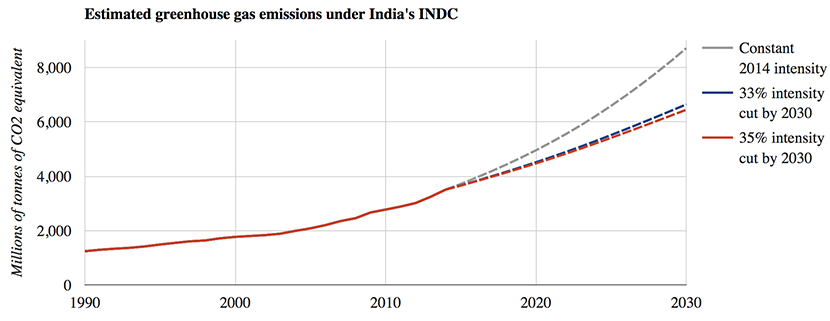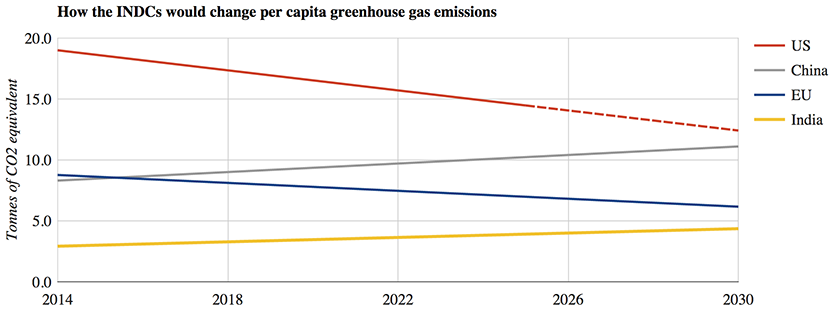Analysis: India’s climate pledge suggests significant emissions growth up to 2030
Multiple Authors
10.02.15Multiple Authors
02.10.2015 | 5:40pmIndia’s greenhouse gas emissions in 2030 would climb by around 90% compared to current levels, according to Carbon Brief analysis of its climate pledge to the UN.
Its intended nationally determined contribution (INDC) promises a 33-35% reduction in emissions intensity by 2030, compared to 2005 levels. This could see India eclipse the EU and US in terms of total emissions in 2030. However, it would remain far below its peers on a per capita basis.
India’s INDC also pledges to nearly triple its renewable energy capacity by 2022 and to raise the share of zero-carbon electricity generating capacity to 40% of the total by 2030.
At $2.5tn over the next 15 years, India’s pledge has a significantly higher price tag than other INDCs. Carbon Brief dives into the numbers and the politics around India’s INDC.
Rising emissions
India’s population and economy are growing rapidly, yet hundreds of millions still live in poverty without access to electricity. So India has been fiercely protective of its right to prioritise economic development.
As a result, its INDC in framed in terms of emissions intensity — the amount of greenhouse gases emitted per unit of GDP. While India’s pledge promises to cut its emissions intensity in 2030 to a third below 2005 levels, its growing economy means actual emissions will still increase.
Carbon Brief analysis of India’s past emissions, GDP forecasts and the emissions intensity pledge suggest its emissions could reach around 6.5bn tonnes of CO2 equivalent (GtCO2e) in 2030, up from 3.5GtCO2e today (red and blue lines, below).
Past (solid line) and estimated future (dashed lines) greenhouse gas emissions in India, depending on the evolution of its emissions intensity. The grey line assumes constant emissions intensity at 2014 levels, and GDP growth according to OECD projections. The blue and red lines assume steady progress towards a 33% or 35% reduction in emissions intensity by 2030, compared to 2005 levels. Source: Carbon Brief analysis based on emissions data from BP and the World Resources Institute, GDP data from the World Bank, GDP growth forecasts from the OECD and India’s INDC.
This growth would put India well ahead of expected emissions from the US or the EU in 2030, but still emitting less than half as much as China. On the other hand, China has pledged to peak its emissions by around 2030, whereas India’s look set to still be increasing at that point.
Renewable goals
Some analysts believe India will surpass its emissions intensity target as a result of separate goals for zero-carbon energy.
Nitin Pandit, chief executive of World Resources Institute India, says in a statement:
“Surprisingly, the country’s carbon intensity target doesn’t fully capture the emissions it would avoid if it succeeds in meeting its renewable energy goals. We expect India can exceed its carbon intensity target in the course of shifting to non-fossil energy.”
The INDC pledges to increase solar capacity 25-fold to 100 gigawatts (GW) by 2022, to more than double wind capacity to 60GW by 2022 and to raise nuclear capacity from 6GW today to 63GW in 2032. In total, India is aiming to install 175GW of renewables by 2022.
If India meets this target, it is likely to far exceed a 2030 goal to increase non-fossil fuels’ share of electricity capacity to 40%, up from 30% today.
Radhika Khosla, fellow at the New Delhi-based Centre for Policy Research, says in a statement:
“India’s INDC target of 40% non-fossil based electricity capacity implies a modest 10% increase from current non-fossil fuel capacity. However, the domestic 2022 renewable energy target of 175GW is far more ambitious. If the challenging domestic 2022 renewable target is met, the 2030 fossil fuel-free target is likely to be exceeded.”
On the other hand, India’s INDC notes that coal “will continue to dominate power generation in future”. Indeed, it has ambitious plans to expand domestic coal mining, implying rapid growth in CO2 emissions.
A further complication in terms of future emissions is that India’s INDC pledges an increase in forest area, creating a carbon sink equivalent to a cumulative 2.5-3GtCO2e by 2030.
Per capita picture
Though India’s pledge could see total greenhouse gas output nearly double by 2030, emissions would remain comparatively low in per capita terms (yellow line, below). Carbon Brief analysis suggests each Indian would be responsible for around 4.3tCO2e in 2030, up by around half from 2.9tCO2e today.
Per capita greenhouse gas emissions in 2014 and 2030, assuming India, China, the US and EU meet their INDCs and population growth follows UN projections. The US INDC runs to 2025; the dashed line assumes continued steady reductions in per capita emissions. Source: Carbon Brief analysis based on the INDCs and UN population projections.
Assuming it meets its INDC, the EU’s per capita emissions would have fallen from 8.8tCO2e today to 6.2tCO2e by 2030. The US and China would nearly converge, with per capita emissions of 12.4 and 11.1tCO2e in 2030, respectively.
By way of context, it’s worth noting that per capita emissions globally need to converge towards around 2GtCO2e in 2050, in order to retain a reasonable chance of avoiding dangerous climate change.
Finance
India says its INDC will cost “at least” $2.5tn to implement, at 2014-15 prices (ie. not taking into account India’s high rate of inflation).
This is a significantly higher price tag than what other countries have put forward to date.
Some 90 other developing countries so far have set out actions in their INDCs that they say would, in total, cost $1.01tn to implement, Carbon Brief analysis shows.
This total comes with caveats – not all countries have put an explicit price on their INDC, for instance – as Carbon Brief has explained. Nonetheless, the highest sum claimed by a country so far has been Ethiopia’s, at $150bn. Most others have been in the tens of billions, or less.
Chart and figures by Carbon Brief
There are reasons why India’s proposed climate actions would be more expensive to implement than other developing countries.
As it points out in its pledge, India is home to 17.5% of the world’s people. Its 1.2bn population is expected to grow to 1.5bn by 2030. It is currently responsible for around 6% of global emissions.
So while India’s INDC may be 16 times more expensive to implement than Ethiopia’s, it is worth bearing in mind that its population is also 13 times larger. On a per capita basis, therefore, their financial estimates are roughly on a par.
As the population both expands and rises out of poverty, electricity demand is also expected to more than triple by 2030, up to 2,499 TWh by 2030.
Making sure this development takes place in a lower-carbon fashion is inevitably going to be an expensive undertaking – although it could also save India at least $23bn a year in reduced fuel imports, according to analysis by the New Climate Institute.
The pledge quotes “preliminary estimates” that India will need around $206bn between 2015 and 2030 in order to prepare for the impacts of climate change. Additional investment will be required for “strengthening resilience and disaster management”.
It also quotes a study by the National Institution for Transforming India, which says that putting India on the path of “moderate low carbon development” would cost $834bn up to 2030.
Meanwhile, the “loss and damage” that India is predicted to face due to climate change is likely to cost 1.8% of India’s GDP every year up to 2050, according to its INDC. Taking into account OECD projections of India’s GDP growth, this amounts to around $758bn by 2030, according to Carbon Brief calculations. Adding these figures together gives a total of around $1.8tn.
India has not explicitly set out how it has arrived at the $2.5tn figure it says it needs to implement its INDC. Neither has it said how much is expected to come from its domestic budget, and how much it expects to receive from international funds. Its scaled-up ambition will require greater resources than are currently being committed by the government, says the INDC.
It makes clear that it will be requesting money from international funds, including the Green Climate Fund. Exactly how much depends on how much India can afford to fund itself, the INDC says, with a “detailed and full scale assessment” of its needs to be finalised at a later stage.
India is not alone in requesting financial help in implementing its climate pledge. Developed countries have promised to provide $100bn a year in climate finance by 2020, and, as a developing nation, India is entitled to access some of this.
But the INDC also suggests that India is prepared to put the weight of its own economy behind its low-carbon transition. Most of India’s current climate finance comes from its own budget, says the INDC. The past two budgets released under prime minister Narendra Modi have allocated funds to addressing climate change.
Meanwhile, the government is experimenting with other means of raising money, according to the INDC. It says:
“India is not relying solely on budgetary resources and is experimenting with a careful mix of market mechanisms together with fiscal instruments and regulatory interventions to mobilize finance for climate change.”
One example is a tax on coal, which is channelled into the National Clean Environment Fund; another is the National Adaptation Fund, which has been given an initial allocated of $55.6m.
Politics
India’s INDC gives a clear indication about the position it will take at the UN climate talks in Paris this December, where a new international agreement is expected to be signed.
Its government has been less forthcoming than other emerging economies, such as China, whose relationship with the US has thawed considerably over the past year. India has been more mysterious and less conciliatory towards developed country parties, hitting out at the “greed and unsustainable lifestyle” of the west.
In particular, the government has pushed the idea of “historical responsibility”, arguing that India’s relatively small emissions over the past centuries means it should face lesser obligations than those whose past development rested on the back of fossil fuel exploitation.
These ideas remain in its INDC, which on its second page accuses developed countries of a “tepid and inadequate” response to climate change.
However, there is much in the document to suggest that India’s position is becoming more positive ahead of the talks this December, according to Harjeet Singh, climate policy manager at ActionAid International.
He tells Carbon Brief that he was impressed at the detail contained in the document, compared to the sparser INDCs produced by parties such as the US and EU. He says:
“I think the entire document has a very positive tone. They’re talking about historical responsibility, they’re talking about finance, but they’re also saying we want to be part of the solution. It’s far more comprehensive than the India that was only talking about technology and finance a couple of years ago.”
Image: Decorated elephant at the annual elephant festival in Jaipur, India. Credit: David Evison/Shutterstock.com.
-
India's greenhouse gas emissions in 2030 would climb by around 90% compared to current levels #INDC
-
India's #INDC promises a 33-35% reduction in emissions intensity by 2030, compared to 2005 levels
-
India says its INDC will cost "at least" $2.5tn to implement - a much higher price tag than other countries have put forward to date





